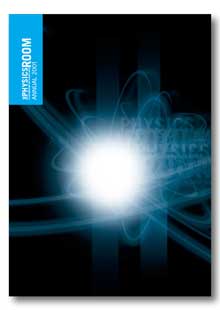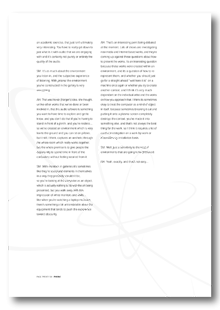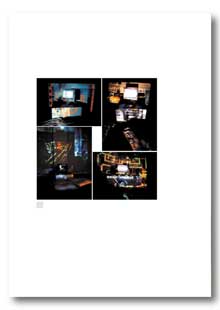 |
|||||||||
|
|
| ...Publications: Annual | ...pHonic | |||||||||
|
pHonic
Adam Hyde talks to Sally McIntyre about (and around) pHonic in an interview originally broadcast on Mag:net Arts talkshow, RDU98:3FM, Christchurch. Sally McIntyre: You state that pHonic "investigates how a traditional relationship is deconstructed by artists who reposition the listener as musician", echoing such musician/software designers as Markus Popp (Oval), who contends he is moving on from a musical art that focuses on the audience to one that focuses on the ‘user’, offering listeners a role change from consumer to producer. Within a world which offers us an increasing immateriality, where instruments have been replaced by software, and whole relationships can be conducted a-physically via communicative technologies, is pHonic about finding your place in technology, perhaps through its use as an artform? Adam Hyde: Your place within technology in terms of the way the computer is actually the interface, and how you respond to it. We’ve come up against the fact that it’s all artificial - icons on desktops have been created; they didn’t exist in nature. We’ve had to work our way through them based on a lineage of understanding that seems intuitive but it’s not necessarily the best way to go. Interface is a very important part of constructing the relationship between yourself and the machine, and that’s very much what a lot of the works investigate, and some of them are straightforward but surprising, and others are more obscure, but all of them provoke a curiosity about: why do we live with these constructs, why aren’t there other investigations going on? SM: You’re interested in a very wide sense in the cultural, theoretical and philosophical issues surrounding technology? AH: Absolutely, but we’re not ‘technology heads’, we’re very interested in the Humanist element of it. For example, the name ‘r a d i o q u a l i a’: its very difficult to define ‘radio’, radio is an extraordinary phenomenon and crosses a lot of areas, you can describe a lot of things via the term, it’s more of the world than we realise. ‘Qualia’ is a philosophical term about the qualitative states of our experience. If you see the colour white, it’s said that you experience ‘white qualia’, so r a d i o q u a l i a is ‘the experience of radio’, but radio in a very broad sense, so it becomes more like ‘the experience of Humanist methods for communication’. Those are the kinds of territories we like to explore as much as possible, both within the technology domain, and specifically within the domain of communication. SM: You’ve talked about sound as one of the major areas of experimental, innovative work in the arts at the moment. Sound is something we’ve become used to basing in objects, like CDs, which are then commodifiable. Napster changed that a lot, but I guess radio has always had that aspect. It seems to change the entire nature of listening to something if it’s not an object that you buy, but more like a process that comes through this technology. AH: Well exactly, and I think that’s really good, because there’s no need to be audiophiles, what’s the point in that? What is it that you’re actually interested in, and what is the experience? Would anyone really want to abstract to the degree where they’re sitting in a blacked out underground bunker to experience pure tone shifts after John Cage? Mostly, music can’t be an academic exercise, that just isn’t ultimately very interesting. You have to really get down to just what is it with audio that we are engaging with and it’s certainly not purely or entirely the quality of the audio. SM: It’s as much about the environment you listen in, and the subjective experience of listening. With pHonic the environment you’ve constructed in the gallery is very welcoming. AH: That was Honor (Harger’s) idea, she thought, unlike other works that we’ve done or been involved in, that this audio software is something you want to have time to explore and get to know, and you don’t do that if you’re having to stand in front of a plinth, and you’re restless... so we’ve created an environment which is very low to the ground and you can sit on pillows, but it still, I think, captures an aesthetic through the whole room which really works together, but the whole premise is to give people the opportunity to spend time in front of the computers without feeling wearied from it. SM: With monitors in galleries it’s sometimes like they’re sculptural elements in themselves in a way they probably shouldn’t be, so you’re looking at the computer as an object, which is actually nothing to do with the art being presented, but you walk away with this impression of white monitors and walls... like when you’re watching a laptop musician, there’s something a bit untranslatable about the equipment that tends to push the experience toward obscurity. AH: That’s an interesting point being debated at the moment. Lots of shows are investigating new media and Internet based works, and they’re coming up against these questions about how to present the works. Its an interesting question because these works were created within an environment, and its a question of how to re-represent them, and whether you should just go for a straight ahead "well here it is" on a machine once again or whether you try to create another context, and I think it’s very much dependant on the individual artist and the works on how you approach that. I think its sometimes okay to treat the computer as a kind of object in itself, because sometimes breaking it out and putting it onto a plasma screen completely destroys the context; you’ve made it into something else, and that’s not always the best thing for the work, so I think it requires a lot of careful investigation on a work-by-work or installation-by-installation basis. SM: Well, just a sensitivity to the kind of environments that are going to be produced. AH: Yeah, exactly, and that’s not easy... View pHonic - curated by r a d i o q u a l i a - Adam Hyde talks to Sally McIntyre as a PDF This interview originally appeared in The Physics Room Annual
2001 Order your copy today from The
Physics Room !
|
|||||||||


